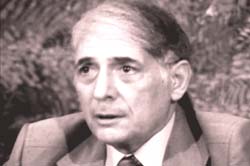 “You shouldn’t end the film that way.”
“You shouldn’t end the film that way.”
This was essentially the sentiment held by a small group of people who saw my documentary about Charles Garry a few weeks ago. I wanted to show the film – still in its “rough” state – to the interviewees who helped shape it. They had all been touched by and closely interacted with the man whose life was presented in the 68-minute long piece.
Charles R. Garry was, as a newspaper editorial put it shortly after his death in 1991, “a life-long fighter for the underdog,” whose clients “had two traits in common: they were outside the American mainstream, and they needed a strong lawyer.” It was exactly his perception of and dealings with these underdogs that attracted me to his story in the first place. The fact that he remained outside the scope of history’s radar despite all his accomplishments was reason enough to develop a film about him. After all, as Black Panther Party Chairman and co-founder Bobby Seale said over thirty years ago: “We don’t know every detail of Charles’ life, but we can see that he is a man who is dedicated to the survival and the existence of the right to self-determination of human beings. We need a lot more history on Charles R. Garry so we can understand what motivates a man to be such a defender of the people’s human rights.”
For those who know the path Garry’s life took, the subject matter of the film’s last fifteen minutes may not seem shocking. Yet for those who do not, the way those fifteen minutes are composed and the abrupt manner in which it all ends seems quite alarming.
In 1977, Garry began working with Peoples Temple, which had managed to establish in the Jonestown community what he himself referred to as “paradise.” The Temple, he believed, picked up where the Movement of the 1960s left off. Their Jonestown experiment, as Garry’s longtime girlfriend Patricia Richartz described it, was like “socialized society.” For this reason, Garry wanted to help the Temple fend off accusations of wrongdoing that were being slung at it.
Of course, he could have never predicted the future; he would have never envisioned himself at the center of a living, breathing nightmare. The tragedy at Jonestown was the hand that he was dealt. And in many ways, it marked his final shot at the table.
Garry continued to practice law after 1978, but the times had changed, and so had his clientele. His days of national acclaim were left in the past, and his post-Jonestown press conferences of November/December 1978 served as his final acts. I wanted the documentary to reflect this. However, this type of conclusion is painful and unwelcome. Seeing a man of Garry’s stature, character, and charm become broken down and teary-eyed at the film’s end is simply heart-wrenching. It is, nonetheless, how it happened. It is also the way in which the film concludes.
It is not a firm conclusion, however. Three minutes have been added to the end. Not many words are spoken during this segment – we hear music and see Garry speaking. My goal with this was to remind audiences about who Garry was and what he stood for. The public’s perception of him may have changed after Jonestown, but Garry’s personal philosophy remained impervious to this. He stood by those who survived and continued to defend their original goals because, after all, he too treasured these same goals.
My only hope is that audiences will be able to see this as well.
(If you are interested in receiving updates about the Charles Garry documentary, Hrag Yedalian invites you to contact him at HRAGY@aol.com.)